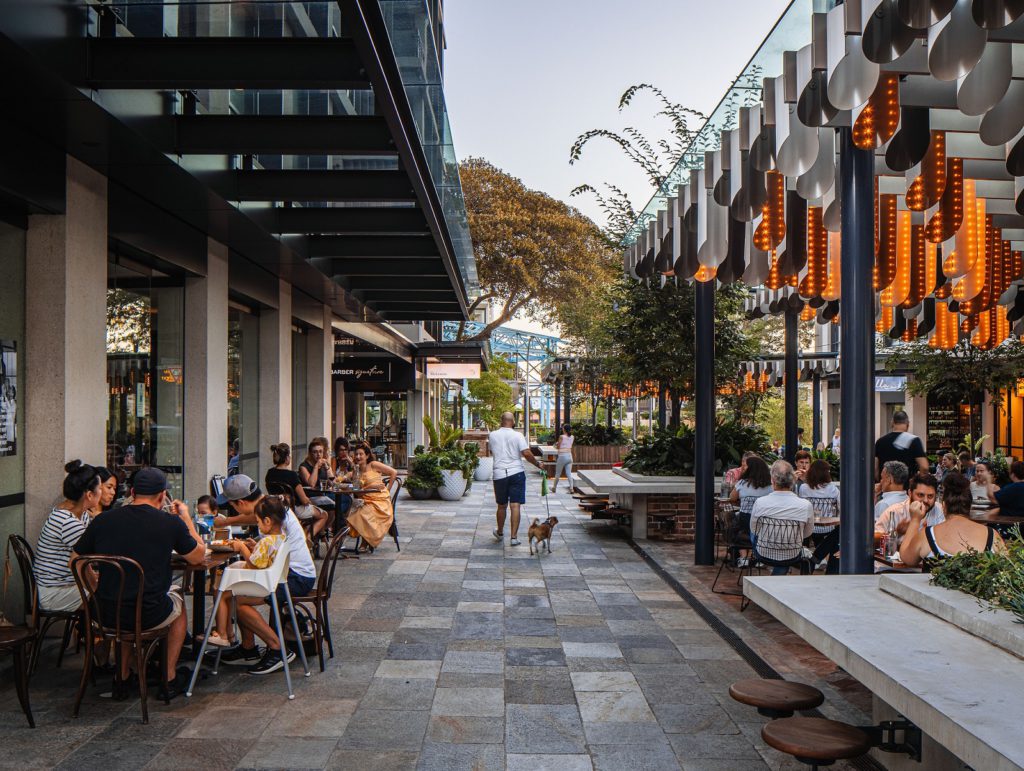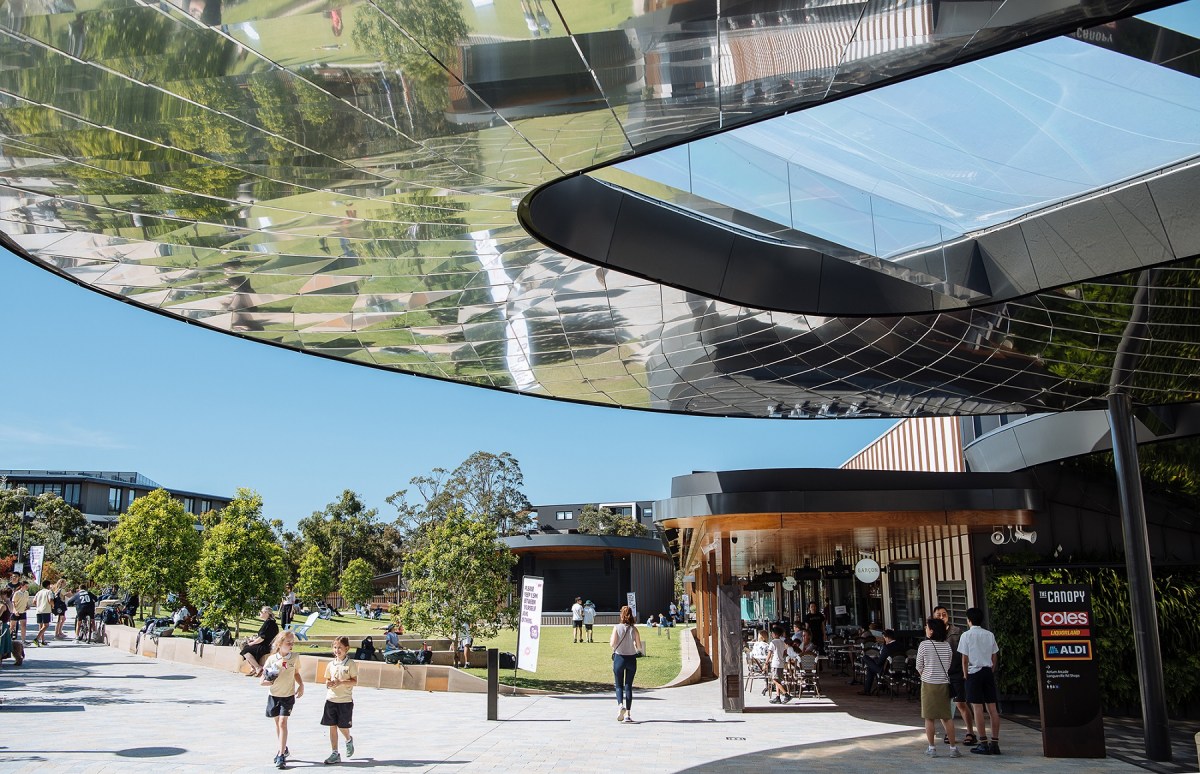When visitors step into The Canopy’s outdoor plaza, at Lane Cove’s reimagined retail centre, they are whisked from the fast-paced chaos of everyday life to a calm but vibrant village atmosphere. The open space embraces the natural landscape the local area prides itself on, creating a unique urban experience for the evolving and growing community of Lane Cove.
After decades as a concrete carpark this recent transformation is warmly welcomed by the neighbourhood, who relish in the new opportunity to gather outdoors with family and friends. With brilliantly-lit alfresco spaces, restaurants, a monthly Makers Market, and an extraordinary playground, it’s easy to forget that people visit The Canopy to simply complete their weekly grocery shop at Aldi or Coles.
Vibrant and dynamic landscapes curated specifically for the community and area they reside in, like The Canopy*, have risen to the top of developers’ to-do lists as they shape the shopping experience of tomorrow.
Moving with the times
There’s no denying that online shopping dominates the retail economy and has been cemented as a permanent part of our lives even before the coronavirus crisis.
As shoppers’ attitudes and behaviours rapidly change, it becomes more important than ever that retail precincts transform into destinations that go above and beyond transactional buying needs. Planning an innately human experience that delivers a sense of community and social engagement can no longer be a design afterthought – instead, it is essential to capturing peoples’ attention in a post-COVID world.
By creating diverse retail spaces with a significant cultural heart, people can be naturally carried from inclusive gathering environments to the commercial core of a development. It inevitably turns a banal shopping task into an enriching experience.
Drawing on community identity
Arcadia has recently delivered eye-catching landscapes to several Australian retail precincts, which connect communities to nature while also boasting exciting outdoor food and beverage plazas and integrated cultural and heritage design.
They’re enhanced with Instagram-worthy style, new technology at visitors’ fingertips and dynamic accessible spaces with multiple uses – and the demand for precincts like this isn’t waning.
At the award-winning Newmarket Dining precinct, visitors dine al fresco under the green climbers and fairy lights in a space which has been designed to include a unique central breakout space that provides designated alfresco dining spaces for the retail tenancies and casual public amenity. The unique precinct character, a combination of the heritage overlay, integrated fixed furniture, lighting, planting and amenity, has created a bustling new community square for Randwick that is full of life, attracting people to the space from sunrise to evening.
We’ve found that these progressive environments that connect with nature can draw people into a precinct for hours on end: from parents with babies in the early morning, to workers clocking off their shift and gathering with friends at night.
That’s exactly what makes our Eastern Creek Quarter in Greater Western Sydney so loved by the community. Our vision to create a retail space beyond peoples’ basic buying needs was achieved through a bespoke play pod for kids, dedicated seating zones and a multi-use outdoor cinema.
In response to Eastern Creek’s population and housing growth, a planting strategy was implemented at the Quarter to ensure the area did not lose its abundance of native landscape. It’s just one of many examples that highlight how considered outdoor environments and inclusive, human-centered spaces can drive community connection.
While retail precincts are no longer just about what people can buy, it’s only natural that incidental shopping happens at these uniquely personable spaces, which are actively engaging from day to night.

Pictured above: Newmarket Dining by Arcadia and Bates Smart [Photographer: Felix Mooneeram]
Mirroring the High Street experience
During the height of pandemic, people rediscovered just how important fresh air and open spaces are to their daily experience and overall wellness.
That’s partly why we’ve seen the popularity of High Street shopping experiences reemerge. Developers must rise to the challenge of replicating a street shopping experience like this at larger shopping centres, in an effort to offer the meaningful cultural experience that neighbourhoods currently crave.
We’ve found that building diverse community hubs with flexible space for outdoor gathering and activities – all nestled among interesting native landscapes – can deliver modern shopping eco systems.
Movable furniture, appropriate natural lighting and access to fresh air, even once entering a retail building, also goes a long way in setting these free-flowing precincts apart from the rest.
We’ve seen this retail revitalisation at the recently-opened Lighthouse development in Dee Why, where shops, offices and more than 350 apartments are found across four high-density buildings.
By activating 3000sqm of space in between the large buildings, we successfully created a north facing piazza where people can soak in the sun or gather on timber decking shaded by native palms, while children engage with a water play space. As a digital retail world takes hold, identifying how physical shopping precincts still play a part in our everyday lives is a challenge the landscape architecture sector can embrace.
But these changing times give us a remarkable opportunity to shape new and existing shopping precincts as thriving, vibrant and culturally cohesive destinations.
By having the foresight to include inclusive outdoor landscapes that keep people connected to their sense of place, retailers have proven that thriving retail economies inevitably follow.
Alex Longley is founding principal of Arcadia Landscape Architects.
Featured image: The Canopy Precinct by Arcadia and Scott Carver [Photographer: Paul McMillan]

